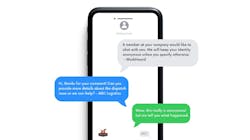Employee feedback: Even gut punches can be a gift, WorkHound CEO says
Slipping your two cents into the workplace suggestion box is a lot like tossing a coin into a wishing well—that bright idea or valid criticism has little chance of seeing the light of day. WorkHound is trying to change that through a new anonymous two-way chat feature added to its employee feedback platform, in an effort to make employers’ retention wishes come true.
As the name suggests, the new feature works by allowing employers to respond directly to negative feedback anonymously entered into the app by workers, opening up a dialogue to fix any problems. The goal, according to WorkHound CEO and co-founder Max Farrell, is to resolve issues before an unhappy worker seeks a new job, while providing a layer of anonymity.
In a typical scenario, a technician might inform management their spouse is not on their insurance and that they are “tired of the runaround and…about to quit,” Farrell explained.
“That's a fixable issue,” he said. “The company would reach out to address that [issue], and they retained a team member because of that.
“But there are also times where they share a comment and they don't want to reveal their identity," Farrell continued. “[The shop worker] wants to stay anonymous and the company still wants to try to resolve that issue.”
The WorkHound founder shared a real trucking scenario where a trainer made two female drivers feel uncomfortable.
“You're in the truck 24 hours a day, so you don't want to pick up the phone and say, ‘Hey, this person's crazy,’” he reasoned. “You want to be able to confidentially share that here's the issue at hand.”
And in an environment where drivers and technicians are in demand, time is of the essence for companies to address any employee grievance.
“A technician can be happy on Tuesday, fed up on Wednesday, and quit by the end of the week—and then be in orientation somewhere else on Monday,” Farrell said. “It’s that volatile.”
Instant feedback also allows management to move more quickly than acting on market data alone. For instance, anonymous feedback from technicians can tell a company that the shop down the road is offering a few more dollars an hour, and they can adjust to become more competitive and retain their workforce—which typically costs far less than hiring a new employee.
Read more: Managing technician pay and quality work
Companies set up who sees the alerts, which could include supervisors, directors, and human resources. While a shop supervisor may dismiss employee complaints about equipment safety, HR can measure those anonymous comments against other locations in the company to discern if there is a systemic problem and act on it, Farrell offered.
“We work with each company to sort out a structure because one of the challenges of workforce listening is that if you only have one person receiving that information, the company is not able to digest it and learn from it and then evolve.”
So far, customer engagement has gone up 950% through use of the chat, according to WorkHound’s product team.
"It's more user friendly and allows for quicker resolution, which helps even more with retention,” said Jennifer Clark, experience improvement manager at USA Truck, a WorkHound customer.
The platform was originally created to bust systemic trucker turnover—trucking companies may experience 95% driver turnover annually. In the time since WorkHound started in 2018, the company has grown to include other transportation frontline workers, including technicians.
And the insights gleaned from surveys sent through the app can help fleets monitor workforce stability, just as telematics data informs them of pending engine trouble.
WorkHound users are also aided by a customer success team that works closely with each company using the platform.
“They have regularly scheduled calls to talk through the feedback, share some of the findings in the data, and just serve as an adviser to the company,” Farrell said. “The benefit is that we get tens of thousands of comments, and watch countless companies go through some of these challenges, so we're able to say, ‘Hey, we've seen this problem before, here's a way to approach that.’”
The app doesn’t do all the work, though.
“Ultimately, it's the candidates on the company to make that action,” Farrell said.
The results suggest that customers are acting on the feedback in a positive way. Farrell said in 2022, “88% of the time, a worker who revealed their identity stayed with the company at least 30 days after.”
Whether the feedback is generated from a company prompt, or comes via an unsolicited anonymous worker, management should see it all as useful data, Farrell argued.
“You can either take feedback as a gift or as an insult,” he said. “The goal here is to make the company better and help the workforce be a better version of itself. If there's a gut punch, the company needs to ask, ‘How might we get better from this?’ And if you have that attitude, then you're able to really improve as an organization.”
About the Author

John Hitch
Editor-in-chief, Fleet Maintenance
John Hitch is the award-winning editor-in-chief of Fleet Maintenance, where his mission is to provide maintenance leaders and technicians with the the latest information on tools, strategies, and best practices to keep their fleets' commercial vehicles moving.
He is based out of Cleveland, Ohio, and has worked in the B2B journalism space for more than a decade. Hitch was previously senior editor for FleetOwner and before that was technology editor for IndustryWeek and and managing editor of New Equipment Digest.
Hitch graduated from Kent State University and was editor of the student magazine The Burr in 2009.
The former sonar technician served honorably aboard the fast-attack submarine USS Oklahoma City (SSN-723), where he participated in counter-drug ops, an under-ice expedition, and other missions he's not allowed to talk about for several more decades.

